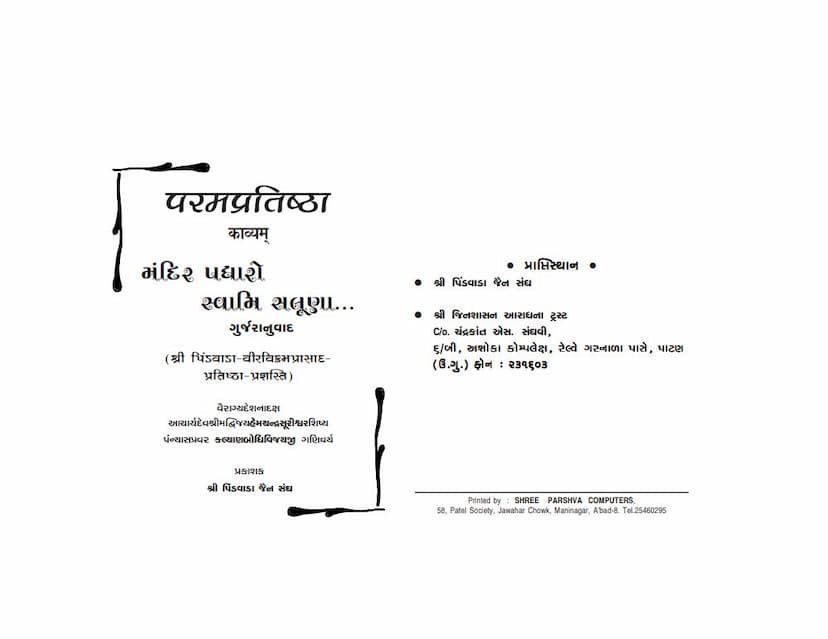Parampratistha
Added to library: September 2, 2025

Summary
This Jain text, titled "Parampratistha" (Perfection of Consecration/Establishment) and authored by Kalyanbodhivijayji, published by Shri Pindwada Jain Sangh, is a poetic work describing the consecration ceremony of a temple dedicated to Lord Mahavir (referred to as Shri Veer). The catalog link provided points to the JAINpedia digital library.
The text emphasizes that the true meaning of "pratistha" (consecration) lies not in the physical presence of the Lord, who has attained liberation, but in the establishment of inner spiritual devotion and purity (Bhav-pratistha). It highlights that while physical presence is temporary, the inner devotion leads to ultimate liberation. This concept is elaborated with references to ancient Jain scholars.
The book describes the consecration ceremony at the Veer Vikram Prasad temple in Pindwada. It traces the history of the temple, including its renovation by prominent figures like Dharanshah, linking it to the grandeur of the Ranakpur temple.
Key themes and content of the text include:
- The Significance of Pratistha: The text argues that true pratistha is the establishment of one's own inner purity and devotion towards the divine. It cites scriptures and scholars like Haribhadra Suri to support this view.
- The Divine Presence: It describes the beauty and spiritual impact of the idols of Lord Mahavir and other Tirthankaras, portraying them as sources of immense joy and spiritual upliftment. The text uses evocative language to describe the serenity and divine aura of the idols.
- The Purity of the Consecrating Acharyas and Munis: The text praises the spiritual caliber of the gurus and munis present during the ceremony, particularly highlighting the spiritual lineage and merits of Acharya Prem Surishwarji and his disciples, including Acharya Yashodev Surishwarji.
- The Grandeur of the Festival: The book details the elaborate arrangements for the pratistha festival, including processions, music, gatherings, and the overall atmosphere of devotion and joy that enveloped the entire town.
- The Five Kalyanaka events: Several sections describe the events of the Five Kalyanaka (conception, birth, renunciation, enlightenment, and liberation) as part of the temple's consecration rituals, particularly focusing on the birth and enlightenment of Lord Shantinath.
- The Role of Devotion: The text consistently emphasizes the power of Jain devotion (Jin-bhakti) and its ability to lead to spiritual merit, worldly prosperity, and ultimate liberation.
- The Virtues of the Gurus: The text includes detailed descriptions of the spiritual qualities, achievements, and contributions of prominent Jain Acharyas and Munis who were part of the event, showcasing their dedication to the Jain faith and their followers.
- The Joy and Spiritual Impact: The narrative conveys the profound joy and spiritual transformation experienced by the attendees during the pratistha, highlighting how the event inspired many to take vows of righteousness and even renunciation.
- The Celebratory Atmosphere: The descriptions of the music, the presence of numerous disciples, the rituals, and the overall festive mood create a vivid picture of the grand celebration.
- The Enduring Legacy: The text concludes by praying for the continued influence of the pratistha and the gurus, wishing for the prosperity and spiritual growth of the community.
In essence, "Parampratistha" is a devotional and descriptive account of a significant Jain religious event, emphasizing the spiritual underpinnings of consecration rituals and celebrating the profound impact of Jain teachings and leadership on the lives of devotees.